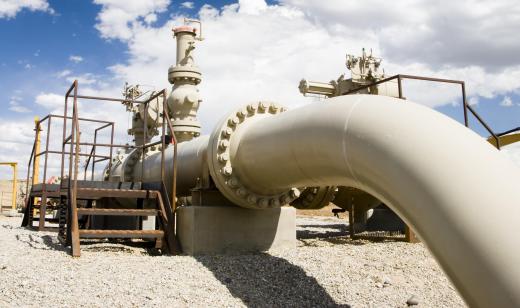A gas holder is a large tank designed for storing natural gas, methane, and similar compounds at the same temperature as the surrounding environment. Historically, such tanks were used to hold a local supply of gas for communities using it as a source of lighting, heat, and cooking fuel. Today, they are more commonly part of the backup systems used to keep a pressurized gas system safe for operation. They can also act to trap gases produced as byproducts of a process so they are not released into the environment.
The device consists of a large tank with a movable top. As the gas holder fills, the top shifts with it, maintaining pressure. Historic gas holders sometimes used a telescoping tank design with two parts that could move closer together and further apart in lieu of a floating top. Flexible balloons can also be used as gas holders in some environments. Pressure allows the gas holder to force gas into pipelines so it can be released as needed.

As historical artifacts, gas holders are objects of interest in some communities. They were typically housed inside large buildings that could dominate the landscape in the middle of a city or town. Tanks inside held the city’s supply of gas, delivering it through the plumbing system to provide fuel for gas lighting and other uses. These gas holders have since been decommissioned with the advent of electricity, but the outer structures remain and in some cases have been preserved by historical societies.
The transition from gas to electricity brought about a number of safety advantages for communities, and the use of gas for lighting is extremely rare in the modern era. Historic gas lighting may be maintained as an object of curiosity in some communities, particularly those that want to retain their historic character, but it is not a primary mode of street or home lightning. Consequently, there is no need for a large reservoir of local gas supplies.
In industrial settings, a gas holder may be used to maintain ambient pressure in a system. It can help the system remain stable even if there are environmental fluctuations. Gas holders trap excess gas to prevent explosions, and can create a temporary reservoir if necessary. They may also be installed over equipment like organic refuse digesters to trap methane and other gases as they are released. These gases can be burned as fuel, making them economically useful to trap, and they are also potential pollutants, so it is important to prevent their escape with a gas holder.
Ever since she began contributing to the site several years ago, Mary has embraced the exciting challenge of being a About Mechanics researcher and writer. Mary has a liberal arts degree from Goddard College and spends her free time reading, cooking, and exploring the great outdoors.

